|
HEAVY METALS IN BLANCO
RIVER SEDIMENTS, VERACRUZ, MEXICO
Trabajo recibido el 23 de junio de 1984
y aceptado para su publicación el 9 de noviembre de
1984.
UBALDINA ÁLVAREZ RIVERA
LETICIA ROSALES HOZ
ARTURO CARRANZA-EDWARDS
Universidad Nacional Autónoma de
México, Instituto de Ciencias del Mar y Limnología,
México, D. F., 04510. México. Contribución 469 del
Instituto de Ciencias del Mar y Limnología, UNAM.
El contenido de materia orgánica, carbonatos y metales traza
así como el tamaño de grano se determinaron en muestras de
sedimento del Río Blanco Veracruz. Las concentraciones de Zn Cu, Fe, Mn
y Ni están en función del tamaño de grano y del contenido
de materia orgánica de los sedimentos. La concentración
más alta de metales totales se encontró en los sedimentos finos
de la Presa de la Tinaja.
Se observó que hasta 22.96
% del peso de sedimento corresponde a la fracción nodetrítica
(soluble en ácido acético) y el resto del peso corresponde a la
fracción detrítica (insoluble en ácido acético). El
Mn es uno de los metales que contribuye más significativamente a la
fracción no detrítica con un aporte de 81.1 % de la
concentración total de Mn en la muestra 2. Se analizaron 3
núcleos de sedimento correspondientes a las diferentes secciones del
río en los que se observaron perfiles de concentración de metales
homogéneos con la profundidad.
Sediments of
the Blanco River have been analysed for grain size, organic matter, carbonates
and trace metals. The concentrations of Zn, Cu, Fe, Mn and Ni are a function of
grain size and organic matter content in the sediments.. The highest total
metal concentration occurs in the fine grained sediments of La Tinaja
dam.
Acetic acid extractions of the sediments indicate that
up to 22.96 % of the sediment weight is contributed by the non-detrital (acetic
acid-soluble) fraction, and the remainder is contributed by the detrital
(acetic acid-insoluble) fraction. Mn makes an important contribution to the
non-detrital fraction with 81.1 % of the total Mn in sample 2 corresponding to
the non-detrital fraction. Analysis of three sediment cores of the different
river sections show an homogencous metal concentration with depth.
The variation in trace metal content of stream sediments is a funetion of several factors as: the influence of lithologic units, the hydrologic effects, the geological features, and the cultural (man-Made) influences (Förstner, 1981). In the present work the study of metal concentration of Blanco's river sediments at different locations were undertaken in order to evaluate the impotance of the different factors that affect their concentration. Total metal concentration in sediments was measured as a function of grain size, and organic matter content of the sediments, besides in order to evaluate the partition of trace metals and the modes of incorporation into the sediments, the detrital and non-detrital fractions of the sediments were studied also. Representative core samples of the different river sections were taken, in order to study the industrial impact on the river metal concentration. STUDY AREABlanco river is located in Veracruz, Mexico (Fig. 1), it flows in W-E direction through the important industrial zone of Orizaba and receives the discharge water of several industries (Fig. 2) and city effluents before reaching Alvarado lagoon in the Gulf of Mexico coastal zone. Three distinctive zones are located in the river in funetion of current velocity, bottom type and water temperature. a) High zone, it has a pronunced slope, high velocity currents, rocky bottom and relatively low temperatures. b) Middle zone, intermediate slope, velocity currents and temperature; it has a sandy bottom. e) Lower zone, low slope and velocity currents, higher temperatures and fine sediment bottom. The mean anual temperatures of the river are 15.8 to 25.2°C (high zone to low zone) and it has a mean anual precipitation from 2500 to 800 mm (high zone to low zone). 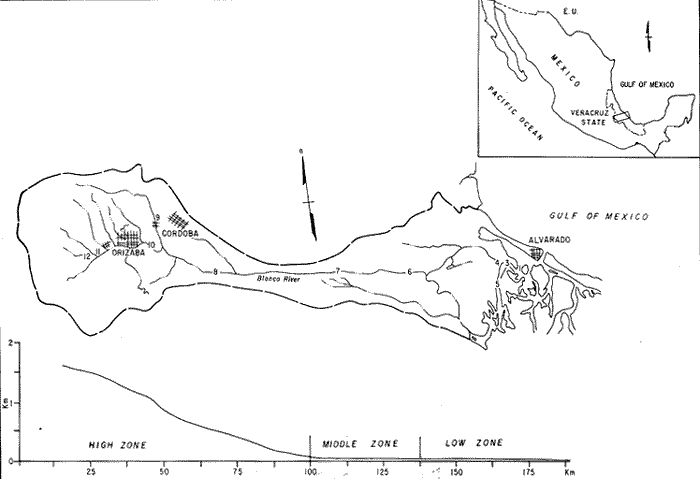 Fig. 1. Sampling point location in the study area. 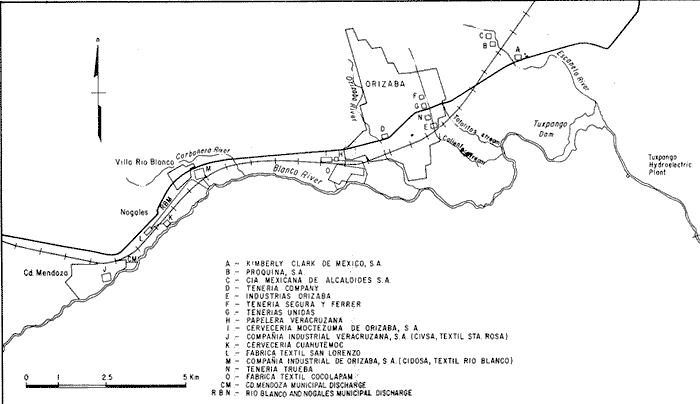 Fig. 2. Industries located in Blanco river basin MATERIAL AND METHODSSamples of sediments were collected during july 1982 (rainy season) and Nov. 1982 (dry season); 12 sampling points were located in the different river sections (Fig. 1). Sediment samples were obtained by the Phleger core sampler or by hand, the cores (60 cm long by 4.7 cm internal diameter) were kept in a vertical position surround by ice and refrigerated as soon as possible; in the high section of the river it was not possible to take sediment cores given the rocky nature of the bottom, therefore surface sediment samples that surround the rocks were taken, this were kept in plastic flasks at 4°C. Salinity, oxygen, temperature and pH data were taken in situ at different levels as a funetion of water depth at the sampling time, the values are shown in Table 1. In order to establish. the distribution and mineralogy (Alvarez, 1983) of suspended matter this was measure at the same levels of the hydrological parameters. Results are shown in Tables 1 and 2. The core samples were examined by X-Ray (58 Kv and 16 m As) those with an homogeneous distribution were divided into four 15-cm portions, the cores with important stratigraphic changes were separated aceordingly. Representative portions of the sediments were dried at 105°C and stored in plastic bags prior to sedimentological and chemical anayIses. Sedimentological analvsis were realized by Folk's method (1951) after organic matter destruction with H2O2. The percentage of organic matter was determined by oxidation with potassium dichromate and titration with ferrous sulfate (Gaudette, 1974) the amount of carbonate was determined measuring the CO2, volume produced by the reaction of the sample with 50 % hydrochIoric acid. Total metal concentration was determined by sample treatment with nitric, perchIoric, fluorhidric and hydrochIoric acids (Bruland, 1974; Jones, 1979). The results for mean graphic size (Mz Ø ), organic matter (%) and total metal concentration are shown (Fig. 3) as a funetion of the distance to the river mouth. 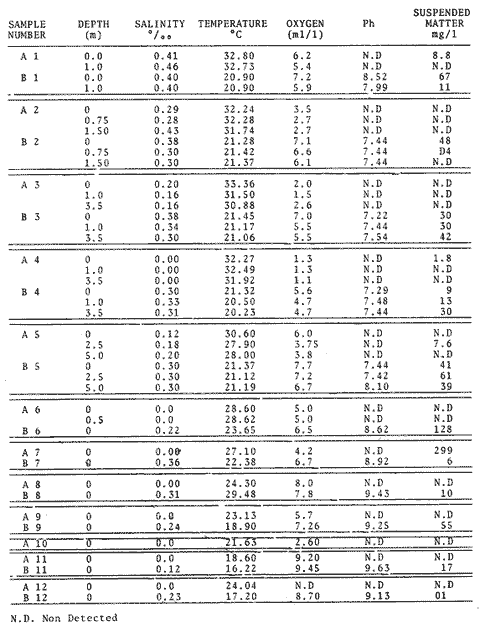 TABLE 1 PARAMETERS MESURED IN THE WATER COLUMN (A-FIRST SAMPLING PERIOD, B-SECOND SAMPLING PERIOD) Non detritic fraction was extracted by treatment of the sediment sample with 25 % acetic acid (Loring, 1977). Metal concentration was measure in an atomie absorption spectrophotometer Varian Models 1200 and 475. 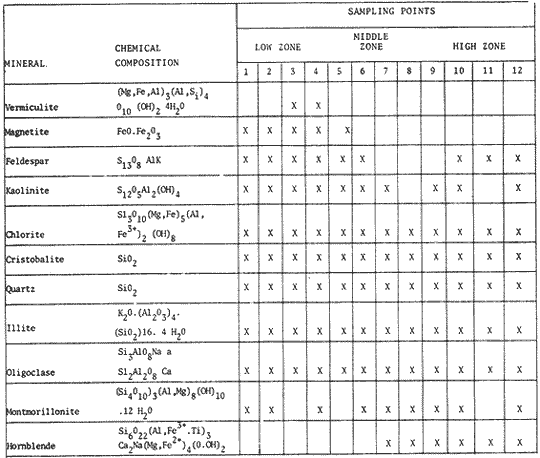 TABLE 2 MINERALES PRESENT IN BLANCO RIVER SEDIMENTS RESULTS AND DISCUSSIONSalinity values of 0.0 to 0.48 near the mouth indicate that marine influence in the river is very low, measurements of the dissolved oxygen in the water (1. 1 to 9.2 ml/l in july 82 and 4.2 to 9.45 m1/1 in nov. 82) shows sobresaturation values in the upper part of the river, these could be produced by the high dynamic of the river in this section. Oxygen concentration is lower in july which could be related to the high amount of organic metter introduced to the river by the sugar refinery industry, given that the recolection and refinery of the plant takes place from Jan. to Jul. The lowest oxygen concentration were always observed near the river mouth and in the dams. pH values of 7.2 to 9.6 were obtained only in nov. 82, the highest values are from the river high section this is the area with the greatest number of industries with alcaline effluents (beer and paper industries), suspended matter concentration (Table 1) vary from 0. 1 to 299 m1/1, the lowest value corresponds to sampling point 12, this is a spring water point where the river is free of any cultural influence. The highest value corresponds to sampling point 7 (La Tinaja dam) located after the industrial area. Large amount of suspended solids accumulate in Tuxpango dam (sampling point 10) water columns with 15 m high suspended solids have been reported, when the amount of solids is high the dam. is open and the materials flow through the river towards the sea; when this happen a great number of organisms in the river die. The river contains several sediment types, in the upper part sand and rocks are found, and in the dam and lower part the sediments become fine. The main grain size is 0.659 to 6.948 (Alvarez, 1983). Organic matter concentration in the sediments vary from 0.01 to 4.8 %; there is a very close relationship between grain size and organic matter concentration (Fig. 3). These correlation is considerably higher in the low river sections (Table 3) where the sedimentation conditions are more stable. 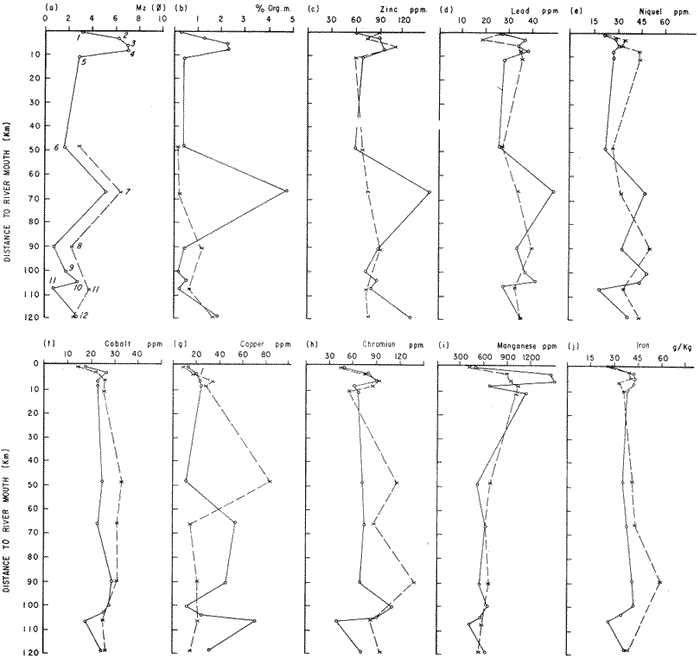 Fig. 3. Mean graphic size (Ø), organic matter (%) and metal concentration (ppm, dry weight basis) in surface sediment samples along Blanco river. TOTAL METAL CONCENTRATIONResults for the trace element analysis in surface sediments are presented in figure 3 as a funetion of the distance of the river mouth; concentrations are reported in mg/kg dry weight basis. An analysis of figure 3 data shows that organic matter content is directly related to Cu, Zn, Ni, Fe and Mn concentration in surface sediments, in the low river sections, these corre-' lation are shown in Table 3; In the river high section the only metal highly related to organic matter concentration is Zn. The relationship of metal concentration to organic carbon may be indicative of complexing and/or adsorption by organic matter, accordin to Jackson (1978) these metals form complexes that are adsorbed on the humic materials, this process could accelerate their deposition. The correlation between metal concentration and organic matter content is higher in the river low zone than in the high zone (Table 3). 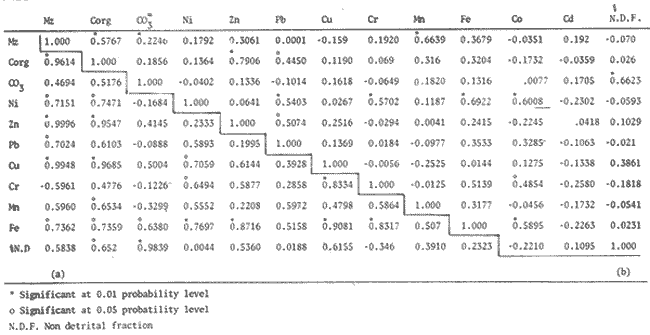 TABLE 3 CORRELATION COEFFICIENTS FOR TOTAL METAL CONTEN IN SURFACE SEDIMENT, a) LOW RIVER ZONE, b) ALL RIVER SECTIONS The greatest change in metal concentration in the two sampling trips corresponds to the river high zone, where there are a great number of industries, the changes are minimum at station 12 (spring water point). Usually metal concentration is higher in samples collected in Nov 82 (dry season) than samples from Jul 82 (rainy season) this could be related to the opening of the Tuxpango and Tinaja dams a few days before the second sampling trip. There is a direct relationship between Ni and Fe, Ni and Co, Ni and Cr and Ni and Pb along all the river sections and a high relationship between Fe and Zn, Fe and Cu Fe and Cr and Fe and Ni in the river low sections, there could be a cooprecipitation of these metals with the magnetite present only in the river low sections (Tables 2 and 3). SEDIMENT CORESThe analysis of three cores (A-1, A-4, A-6) of the different river sections was realized. Data are shown in Table 4, two cores correspond to the lower zone and one core corresponds to the river middle zone; it is observed that Ni, Zn, Cr, Fe and Mn concentration is uniform through the cores or increases slight1y with depth, Mn and Fe are considered mobile elements given that their concentration is a funetion of the physicalchemical properties of the core; the upward migration of soluble Mn under reducing conditions in sediment pore water with surface precipitation by oxidation it is well known, when surface enrichment of Mn concentration is not found it is believed that the redox condition through the core are such that overall precipitation of upward migrating Mn is not ocurring and the Mn is being lost to the overlying waters, the similarity in Fe and Mn profiles (Table 4) suggest that Fe is also being mobilized in the sediments. Co and Cd appear to have an homogeneous distribution through the core, while Cu and Pb have an slight increase in the surface of the cores located in the river low zone, while the cores located in the middle zone show no increase; the high concentration of Al (3.8 - 9.9 %) and Fe (2.8 - 6.5 %) reflect the mineralogical composition of the samples. X-Ray data of surfase sediments at each sampling point shows the minerals present at each station (Table 2) these data and the sedimentological data (Alvarez, 1983) that show that the A-1 and A-6 cores are mainly sand formed, support the fact the Al concentration comes mainly from feldespats, and Fe concentration originate in the magnetita minerals; Core A-4 is formed by 20 % clay minerals, therefore the minerals that can contribute to the Al concentration are: kaolinite, chlorite, illite and montmorillonite and the minerals than can contribute to the Fe concentration are magnetite, chIorite and vermiculite. An analysis of the sedimentological parameters in the cores shows a great difference from one trip to the other which is a function of the opening of the dam, an example is core A-7 (Tinaja dam) (Table 4) which shows the high sediment deposition that is taking place at this point. CHEMICAL PARTITIONIn all samples the detrital fraction was the predominant sedimentay component, chemical partition reveals that 1. 33 to 22.96 % of the sediment is contributed by the non-detrital fraction, the percentage of detrital fraction is a function of the sedient location along the river (Table 5). The amount of metals contributed by nondetrital fraction are: 0. 14 % of the total Ni, 1.44-21.2% of the total Zn, 0- 12.94 % of the total Pb, 0.9-13.87 % of the total Co, 0-28.83 % of the total Cd, 6.57-81.1 % of the total Mn, and 0. 81-7.76 % of the total Fe. None Cu and Cr concentration were observed in the non detrital fraction. 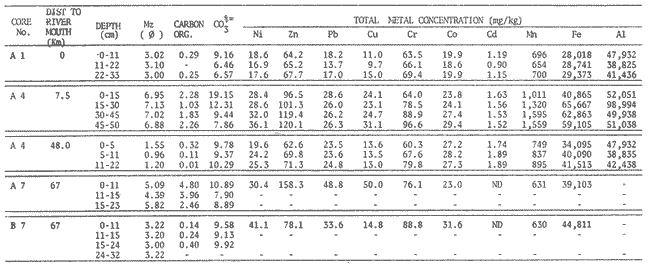 TABLE 4 GRAIN SIZE. (Ø), ORGANIC MATTER (%) AND TRACE METAL CONCENTRATION (MG/KG) DRY WEIGHT BASIS FOR SEDIMENTS CORES OF BLANCO RIVER (A: JUL. 82, B: NOV. 82) 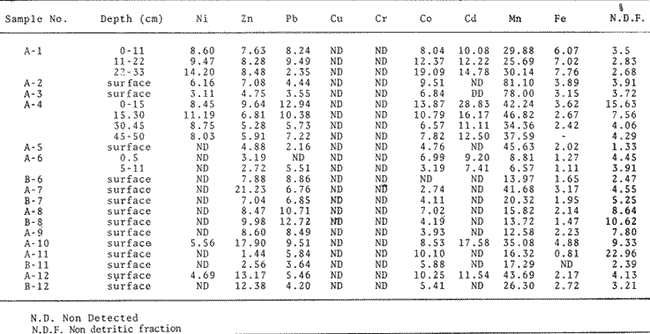 TABLE 5 METAL PERCENTAGE IN THE NON-DETRITIC FRACTION Even when the leachable inorganic material in these sediments is small, this fraction is an important component for some metals as Mn, and Zn. In these two elements the deposition of hydrogenous materials makes a significant contribution to these elemental enrichment in the overall bulk sedimentary composition. Fe is a predominant constituent of the parent matrix material therefore the increase in concentration produced by hydrogenous deposition is small relative to Mn. Processes transfering transition metals from solution to the solid phase increase the concentration of Zn, Mn, Co, Cd. and Fe in surface sediments at station A-4 and A-6. Station A-1 shows a different pattern, at this point there is a high dynamic of the system, higher oxygen concentration are observed, organic matter content is low and the sediments is formed mainly by sand (91 %). The percentage of non-detritic fraction is a direct funetion of the carbonate content of the sample (Table 3). The coorelation of Mz with organic matter, and Mn and Zn is high along the river different sections (Table 6). ConclusionesCONCLUSIONSTrace metal concentration in Blanco River are comparable to values found elsewhere in reported unpolluted areas of the world. The incorporation of Pb, Zn, Ni, Cu and Cr bearing minerals into the sediment at the same rate as other detrital sedimentary material has made the largest contribution to the total metal concentration in sediments. Significant quantities of Zn, Cd and Mn occur in the nondetrital fraction althotigh the contribution this fraction makes to total elemental concentration is less than 23 %, the higher concentration in nondetrital metal concentration corresponds to Tinaja dam where the aceumulation of high amounts of sediment rich in organic materials from industrial discharges takes place; an analysis of trace metal concentration in the cores shows that the industrial development has not increase the metal concentration in sediments significantly. Trace metal concentration is direedy related to the sedimentological comentaristics of the sediment and its organic matter content, through the formation of organic complexes with the metals. 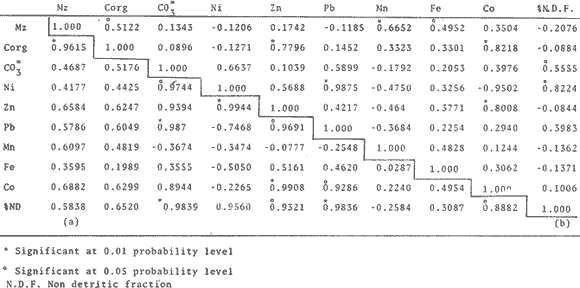 TABLE 6 CORRELATION COEFFICIENTS IN THE NON-DETRITIC FRACTION. A) LOW RIVER ZONE. B) ALL RIVER SECTIONS AgradecimientosACKNOWLEDGMENTSThe authors gratefully acknowledge, the assistance of David Valdez and Joaquin Aguilar in the collection of the samples. LITERATURAÁLVAREZ-RIVERA, V. Master Degree Thesís. Distribución de Metales Pesados en Sedimentos del Rio Blanco, Veracruz. CCH-UNAM. 1983 FOLK, R. L. Stages of textural maturity in sedimentary rocks. 1. Sedim. Petrol. 1951 127-130 21 FÖRSTNER, V. and G.T.M. WITTMAN Metal Pollution in the Aquatic Environment. Springer Verlag 1981 486 P. GAUDETTE, H.E., W.R., FLIGHT, E. TORNER and D.W., FOLGER An inexpensive titration method for the determination of organic carbon in recent sediments. 1. Sedim. Petrol. 1974 249-253 (1) 44 JACKSON, K.S., R.J. JONASSON and J.B. SKIPPEN The nature of metal-sediment-water interactions in freshwater bodies, with emphasis on the role of organic matter. Earth Science Reviews 1978 97-146 14 JONES, G.B. and M.E. JORDAN The distribution of organic material and trace metals in sediments from the River Liffey Estuary. Estuarine and Coast Marine Science Dublin 1979 37-47 8 LORING, D.H. and R.T. RANTALA Geochemical analysis of marine sediments and suppended particulate matter. Fisheries and marine Service Technical, Rep. 700 Canada 1977 58 p SECRETARÍA DE RECURSOS HIDRÁULICOS Programa 1971-1976. Protección y mejoramiento de la calidad del agua. Resultados y proyecciones, planes y estrategias nacionales. (S.R.H.) México 1976
|

